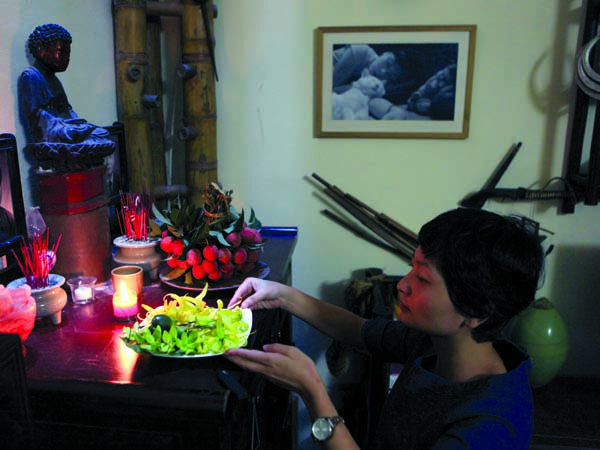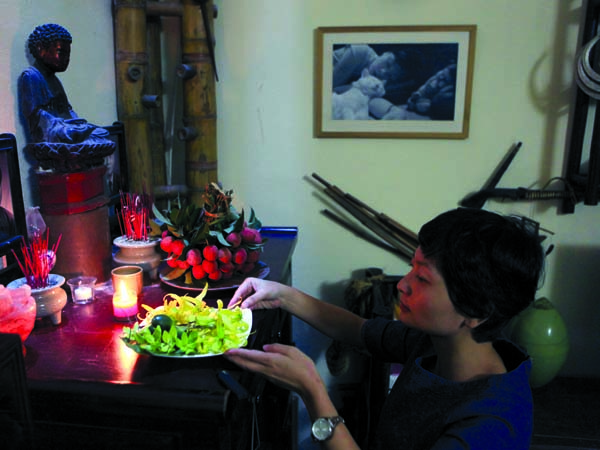(No.2, Vol.8,Apr-May Vietnam Heritage Magazine)





On the occasions of New Year’s, new moon, full moon and commemoration of dead relatives, the Vietnamese always have on the altar a plate of flowers and another one with betel and areca.
Writer Bang Son once wrote, ‘The plate normally contains many kinds of flowers. Plucked from their twig, the lone flowers lie on a dry, clean plate. It can be a fragrant white lily, a sweet magnolia or an elusively aromatic acacia. Sometimes, it may be a cholorantus, a wild daisy, a dahlia or even a bunch of dried flowers. In scarce seasons, even some cockscomb can also be seen here. The flower content and amount depend on the season and weather.’
Bang Son’s writing about flower plates seems so distant, so lost in oblivion. I and many I know never use anything other than vases to arrange flowers, no matter the purpose. But after some inquiries, I leaned that in Hanoi there are still at least two places that sell plate flowers for the altar: Mrs. Thu’s on Hang Khoai Street and Mrs Xay at Quang An flower bazaar. Mrs Thu has been selling flowers on Hang Khoai Street since she was 13, that is, for 63 years. ‘I remember selling gladioli to French ladies.’ Mrs Thu’s so called shop consists of just a few plastic baskets and a bucket full of water, all lined up along the sidewalk. From January to April, Mrs Thu sells pomelo flowers and jasmines. From April to July she sells Ylang-Ylang, cananga, magnolia, jasmines and peonies. March-April, which is the pomelo blossom season, she ties 3-5 small branches into bundles and sells them for about 15 thousand dongs a bundle. People like these flowers for their pure beauty and noble aroma. A plate of flowers can stay fresh for 3-5 days. For just about 30-50 thousand dongs one can have champaca, magnolia, peony and cananga, plus betels and areca. Put all on a single plate and place on the altar for the new moon or full moon celebration, and you have a job well done. Mrs. Thu always has fresh flowers suitable for the seasons.
From Mrs Thu’s shop I came to visit Mrs Xay’s at Quang An flower bazaar. Mrs Xay had two flat baskets of mixed flowers: peonies, Ylang-Ylang, roses and areca spadices. Interestingly, Mrs Xay still wraps the flowers in a canna leaf and ties the bundle with a bamboo strip like in the old days. ‘People used to buy a lot, so I used to peddle in the streets. Early morning the new moon or full moon days, I just hung the bundle on their doors and collected the money later.’
So, I wonder since when did people start offering flowers in a plate? And is there anyone who still does so? I am told that the plate flowers should have special fragrance. A child of flower village of Ngoc Ha, with several ancestral generations growing and selling flowers, Mrs Thu remarks, ‘It seems irreversible. Two generations before me and mine used to offer flowers in plates, but my kids and grand kids don’t. On the occasions of New Year, new moon, full moon and others my family always has three flower plates offered on the altar: one for the ancestors, one for the grandparents and one for the parents. We used to collect wild flowers such as pergularia, ngâu (Aglaia duperreana) or cholorantus too. But now they don’t buy those anymore.’
While Mrs Thu told her story, a few young people came to buy flowers. A 30-ish woman said, ‘Offering flowers in a plate was my mother’s habit. We just keep on doing so.’ Mrs Thu added, ‘Nowadays some youth buy my flowers just to please their senses, not for offerings.’
Offering flowers in a plate is simple and delicate. It shows respect and gratitude in an elegant way. Bang Son said ‘A rich tray is just one way to express one’s feelings.’ What a pity if this will one day be all gone.

